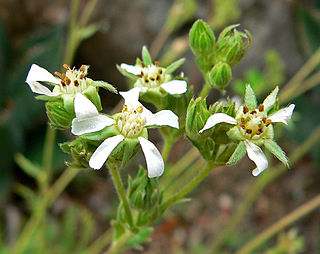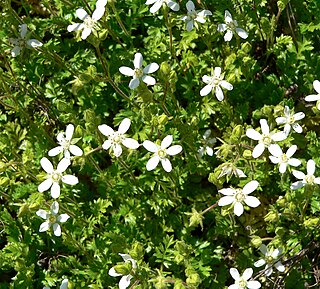
Horkelia is a genus of plants in the rose family. It includes several species of plants known commonly as horkelias. These are flowering plants closely related to the cinquefoils (Potentilla) and sometimes considered part of the same genus. There are nineteen species found in western North America, especially California. Horkelia was named for German scientist Johann Horkel.

Helianthus bolanderi is a species of sunflower known by the common names Bolander's sunflower and serpentine sunflower. It is native to California and Oregon, where it grows mainly in mountainous areas, often in serpentine soils. It has been found from southwestern Oregon as well as in northern and central California as far south as Santa Cruz County, with reports of a few isolated populations in southern California.

Potentilla californica, also known as California horkelia, is a species of flowering plant in the rose family.

Potentilla clevelandii, also known as Cleveland's horkelia, is a species of flowering plant in the rose family. It is native to the Peninsular Ranges of southern California and northern Baja California.

Potentilla lindleyi, commonly known as wedgeleaf horkelia, is a species of flowering plant in the rose family. It is endemic to California, where it grows in coastal chaparral communities and sandy areas.

Potentilla daucifolia, commonly known as carrotleaf horkelia, is a species of flowering plant in the rose family. It is native to the Klamath Mountains and surrounding ranges in northern California and southern Oregon. It grows on mountain slopes and fields, often on serpentine soils.

Potentilla douglasii is a species of flowering plant in the rose family known by several common names, including pinewoods horkelia and dusky horkelia. It is native to the western United States from California to Wyoming, where it is generally found in mountain forests and meadows.

Potentilla marinensis, commonly known as Point Reyes horkelia, is a rare species of flowering plant in the rose family. It is endemic to the California coastline, where it is known from about Fort Bragg to near Santa Cruz. It grows on beaches and in other sandy coastal areas.

Potentilla parryi, commonly known as Parry's horkelia, is a species of flowering plant in the rose family. It is endemic to California, where it grows in the chaparral of the Sierra Nevada foothills.

Potentilla sericata, commonly known as silky horkelia, is a species of flowering plant in the rose family. It is native to the Klamath Mountains of northern California and southern Oregon, where it grows in the chaparral and forest, often on serpentine soils.
Horkelia tridentata is a species of flowering plant in the rose family known by the common name threetooth horkelia. It is native to all of the mountain ranges of northern California and southern Oregon, where it grows in coniferous forest. This is a perennial herb forming tufts of erect leaves and stems. The leaves are 3 to 12 centimeters long, each made up of hairy gray-green leaflets which are tipped with usually three teeth. Unlike many other horkelias, this species is generally not strongly scented. The green or reddish stems reach a maximum length of about 40 centimeters and hold clusters of flowers. Each flower has minute bractlets beneath small, hairy, pointed sepals and narrow white petals.

Astragalus bolanderi is a species of milkvetch known by the common name Bolander's milkvetch. It is native to western Nevada and parts of the Sierra Nevada in California. It grows in dry, rocky habitat on mountain and plateau.

Potentilla hendersonii, commonly known as Henderson's horkelia, is a rare species of flowering plant in the rose family. It is known from four populations in southern Oregon, including Mount Ashland, and one population south of the border in Siskiyou County, California. It is a resident of dry forest habitat in the granite soils of the Klamath Mountains.

Potentilla hispidula, commonly known as White Mountains horkelia, is a species of flowering plant in the rose family. It is endemic to the White Mountains, a small range of mountains that straddles the border between California and Nevada east of the Sierra Nevada. It is a resident of dry scrub and alpine and subalpine forest habitat.

Potentilla rydbergii, commonly known as Rydberg's horkelia, is a species of flowering plant in the rose family. It is endemic to the Transverse Ranges of southern California, where it grows in several types of habitat, including pine forest.

Horkelia tenuiloba is a species of flowering plant in the rose family known by the common names Santa Rosa oceanspray, Santa Rosa horkelia and thin-lobed horkelia. It is endemic to California, where it is known only from the coastal hills and mountains north of the San Francisco Bay Area. It is a plant of chaparral habitat. This is a perennial herb producing a low mat of hairy, glandular green foliage around a woody base. The leaves are cylindrical or somewhat flat, often tapering to a point, and each is made up of several densely packed pairs of hairy leaflets. The inflorescence is an array of flowers atop an erect stalk, each flower made up of five pointed green sepals and five white petals. At the center of the flower is a cone of stamens tipped with reddish anthers around many pistils. It flowers in May. It is threatened by trampling, trail maintenance, and development.
Horkelia yadonii is a rare species of flowering plant in the rose family known by the common name Santa Lucia horkelia. It is endemic to California, where it is known from the Central Coast Ranges from Monterey to Santa Barbara Counties. It occupies chaparral and woodland habitat, often in meadows and dry riverbeds. Easily confused with related species, this plant was not recognized as a species of its own until 1993. This is a perennial herb producing hairy, glandular, gray-green mat of erect leaves around a caudex. Each leaf is up to 20 centimeters long and is made up of several pairs of wedge-shaped to rounded leaflets with lobed to deeply notched tips. The inflorescence is an open array of 5 to 10 flowers atop a tall, erect stalk, each flower made up of five pointed, green sepals and five white petals

Agnorhiza bolanderi is a species of flowering plant known by the common name Bolander's mule's ears. It is endemic to California, where it is known only from a narrow section of the Sierra Nevada foothills about 275 kilometers long from Shasta County to Mariposa County. It grows in chaparral and grassland habitat, usually on serpentine soils.

Potentilla villosa is a species of flowering plant in the rose family, Rosaceae. Its common names include villous cinquefoil, northern cinquefoil, and hairy cinquefoil. It is native to northwestern North America, where its distribution extends from Alaska to Alberta to Oregon. There are records from eastern Asia.
Potentilla johnstonii is a rare species of flowering plant in the rose family known by the common name sagebrush cinquefoil. It is native to Nevada, where it has been collected from only one spot in the Quinn Canyon Range of Nye County.

















